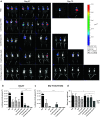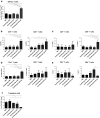Cryoimmunotherapy with local co-administration of ex vivo generated dendritic cells and CpG-ODN immune adjuvant, elicits a specific antitumor immunity
- PMID: 24452202
- PMCID: PMC11029716
- DOI: 10.1007/s00262-014-1520-4
Cryoimmunotherapy with local co-administration of ex vivo generated dendritic cells and CpG-ODN immune adjuvant, elicits a specific antitumor immunity
Abstract
Cryoablation is a low-invasive surgical procedure for management of malignant tumors. Tissue destruction is obtained by repeated deep freezing and thawing and results in coagulative necrosis and in apoptosis. This procedure induces the release of tumor-associated antigens and proinflammatory factors into the microenvironment. Local administration of immature dendritic cells (DCs) potentiates the immune response induced by cryoablation. To further augment the induction of long-lasting antitumor immunity, we investigated the clinical value of combining cryoimmunotherapy consisting of cryoablation and inoculation of immature DCs with administration of the immune adjuvant, CpG oligodeoxynucleotides. Injection of the murine Lewis lung carcinoma, D122-luc-5.5 that expresses the luciferase gene, results in spontaneous metastases, which can be easily monitored in vivo. The local tumor was treated by the combined treatment. The clinical outcome was assessed by monitoring tumor growth, metastasis in distant organs, overall survival, and protection from tumor recurrence. The nature of the induced T cell responses was analyzed. Combined cryoimmunotherapy results in reduced tumor growth, low metastasis and significantly prolonged survival. Moreover, this treatment induces antitumor memory that protected mice from rechallenge. The underlying suggested mechanisms are the generation of tumor-specific type 1 T cell responses, subsequent induction of cytotoxic T lymphocytes, and generation of systemic memory. Our data highlight the combined cryoimmunotherapy as a novel antitumor vaccine with promising preclinical results. Adjustment of this technique into practice will provide the therapeutic benefits of both, ablation of the primary tumor and induction of robust antitumor and antimetastatic immunity.
Conflict of interest statement
The authors declare that they have no conflict of interest.
Figures






Similar articles
-
The Application of Cytidyl Guanosyl Oligodeoxynucleotide Can Affect the Antitumor Immune Response Induced by a Combined Protocol of Cryoablation and Dendritic Cells in Lewis Lung Cancer Model.Med Sci Monit. 2016 Apr 19;22:1309-17. doi: 10.12659/msm.898194. Med Sci Monit. 2016. PMID: 27092689 Free PMC article.
-
Combined dendritic cell cryotherapy of tumor induces systemic antimetastatic immunity.Clin Cancer Res. 2005 Jul 1;11(13):4955-61. doi: 10.1158/1078-0432.CCR-04-2422. Clin Cancer Res. 2005. PMID: 16000595
-
Enhanced tumor-specific long-term immunity of hemagglutinating [correction of hemaggluttinating] virus of Japan-mediated dendritic cell-tumor fused cell vaccination by coadministration with CpG oligodeoxynucleotides.J Immunol. 2004 Oct 1;173(7):4297-307. doi: 10.4049/jimmunol.173.7.4297. J Immunol. 2004. PMID: 15383558
-
Immunological Aspects of Cryoablation of Non-Small Cell Lung Cancer: A Comprehensive Review.J Thorac Oncol. 2018 May;13(5):624-635. doi: 10.1016/j.jtho.2018.01.017. Epub 2018 Jan 31. J Thorac Oncol. 2018. PMID: 29391289 Review.
-
Nanomaterial-assisted delivery of CpG oligodeoxynucleotides for boosting cancer immunotherapy.J Control Release. 2024 Dec;376:184-199. doi: 10.1016/j.jconrel.2024.09.044. Epub 2024 Oct 11. J Control Release. 2024. PMID: 39368710 Review.
Cited by
-
Mechanical high-intensity focused ultrasound creates unique tumor debris enhancing dendritic cell-induced T cell activation.Front Immunol. 2022 Dec 7;13:1038347. doi: 10.3389/fimmu.2022.1038347. eCollection 2022. Front Immunol. 2022. PMID: 36569907 Free PMC article.
-
The Animal Lectin Galectin-8 Promotes Cytokine Expression and Metastatic Tumor Growth in Mice.Sci Rep. 2020 Apr 30;10(1):7375. doi: 10.1038/s41598-020-64371-z. Sci Rep. 2020. PMID: 32355198 Free PMC article.
-
The Application of Cytidyl Guanosyl Oligodeoxynucleotide Can Affect the Antitumor Immune Response Induced by a Combined Protocol of Cryoablation and Dendritic Cells in Lewis Lung Cancer Model.Med Sci Monit. 2016 Apr 19;22:1309-17. doi: 10.12659/msm.898194. Med Sci Monit. 2016. PMID: 27092689 Free PMC article.
-
[Current Status and Progress of Thermal Ablation Combined with Immunotherapy for Lung Tumors].Zhongguo Fei Ai Za Zhi. 2022 Apr 20;25(4):266-271. doi: 10.3779/j.issn.1009-3419.2022.102.09. Zhongguo Fei Ai Za Zhi. 2022. PMID: 35477191 Free PMC article. Review. Chinese.
-
Interventional Oncology and Immuno-Oncology: Current Challenges and Future Trends.Int J Mol Sci. 2023 Apr 16;24(8):7344. doi: 10.3390/ijms24087344. Int J Mol Sci. 2023. PMID: 37108507 Free PMC article. Review.
References
Publication types
MeSH terms
Substances
LinkOut - more resources
Full Text Sources
Other Literature Sources
Medical

